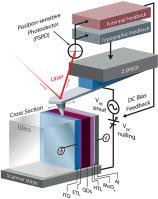Nano Energy ( IF 16.8 ) Pub Date : 2020-08-28 , DOI: 10.1016/j.nanoen.2020.105319 Chuanxiao Xiao , Qian Zhao , Chun-Sheng Jiang , Yinong Sun , Mowafak M. Al-Jassim , Sanjini U. Nanayakkara , Joseph M. Luther

|
Colloidal halide perovskite nanocrystals or quantum dots (QDs) show similar defect tolerance as thin film perovskite materials with added nanoscale phenomena. Perovskite QD solar cells have demonstrated efficiencies of 16.6%, greater than that of any other QD material system. While the efficiency lags behind the best thin-film perovskite devices, these solar cells could have advantages over the thin-film versions in terms of processability, phase stability, and high open-circuit voltages. However, some operating principles behind perovskite quantum dot device stacks and the associated electric field properties are still unknown. Here, we characterize the junction structure within perovskite QD solar cells, by exposing functioning cross-sections and using nanometer-scale Kelvin probe force microscopy to offer insight into the selection and performance of charge selective contacts. We also evaluated various solar cell device architectures with different selective contacts to isolate the role of each junction in device performance. We show that in high-performance n-i-p architectures, both electron- and hole-transport layer (HTL) interfaces possess a strong electric field, but in the case of the inverted p-i-n architecture, we find that high interfacial recombination at the HTL/QD junction is responsible for subpar device performance. Perovskite QD and thin film materials can synergistically be combined to offer more design flexibility in PV devices, and here we demonstrate that the interface between perovskite thin films and QDs are relatively benign and amenable for synergistic device design.
中文翻译:

钙钛矿量子点太阳能电池:映射界面能学以改善电荷分离
胶态卤化物钙钛矿纳米晶体或量子点(QD)显示出与薄膜钙钛矿材料相似的缺陷耐受性,并增加了纳米级现象。钙钛矿QD太阳能电池的效率已证明为16.6%,高于任何其他QD材料系统。尽管效率落后于最佳的钙钛矿薄膜器件,但这些太阳能电池在可加工性,相稳定性和高开路电压方面可能比薄膜型具有优势。然而,钙钛矿量子点器件堆叠背后的一些工作原理以及相关的电场性质仍然未知。在这里,我们描述了钙钛矿QD太阳能电池内的结结构,通过暴露有效的横截面并使用纳米级的Kelvin探针力显微镜,可以深入了解电荷选择性触点的选择和性能。我们还评估了具有不同选择性触点的各种太阳能电池器件架构,以隔离每个结在器件性能中的作用。我们展示了高性能压区架构中,电子传输层和空穴传输层(HTL)界面都具有很强的电场,但是在倒置引脚架构的情况下,我们发现HTL / QD结处的高界面重组是导致性能不佳的原因。钙钛矿QD和薄膜材料可以协同结合,以在PV器件中提供更多的设计灵活性,在这里,我们证明了钙钛矿薄膜和QD之间的界面相对良性并且适合于协同器件设计。











































 京公网安备 11010802027423号
京公网安备 11010802027423号